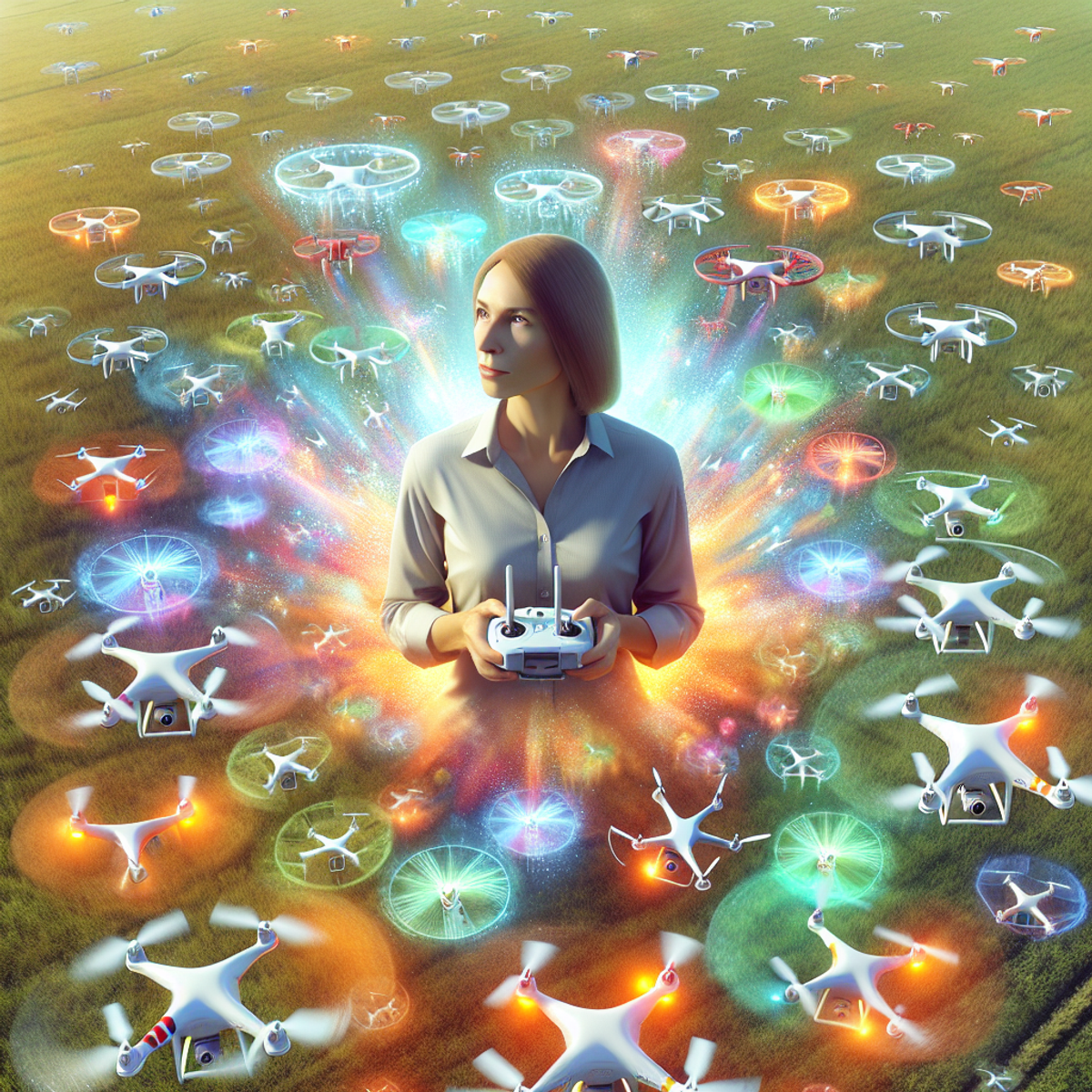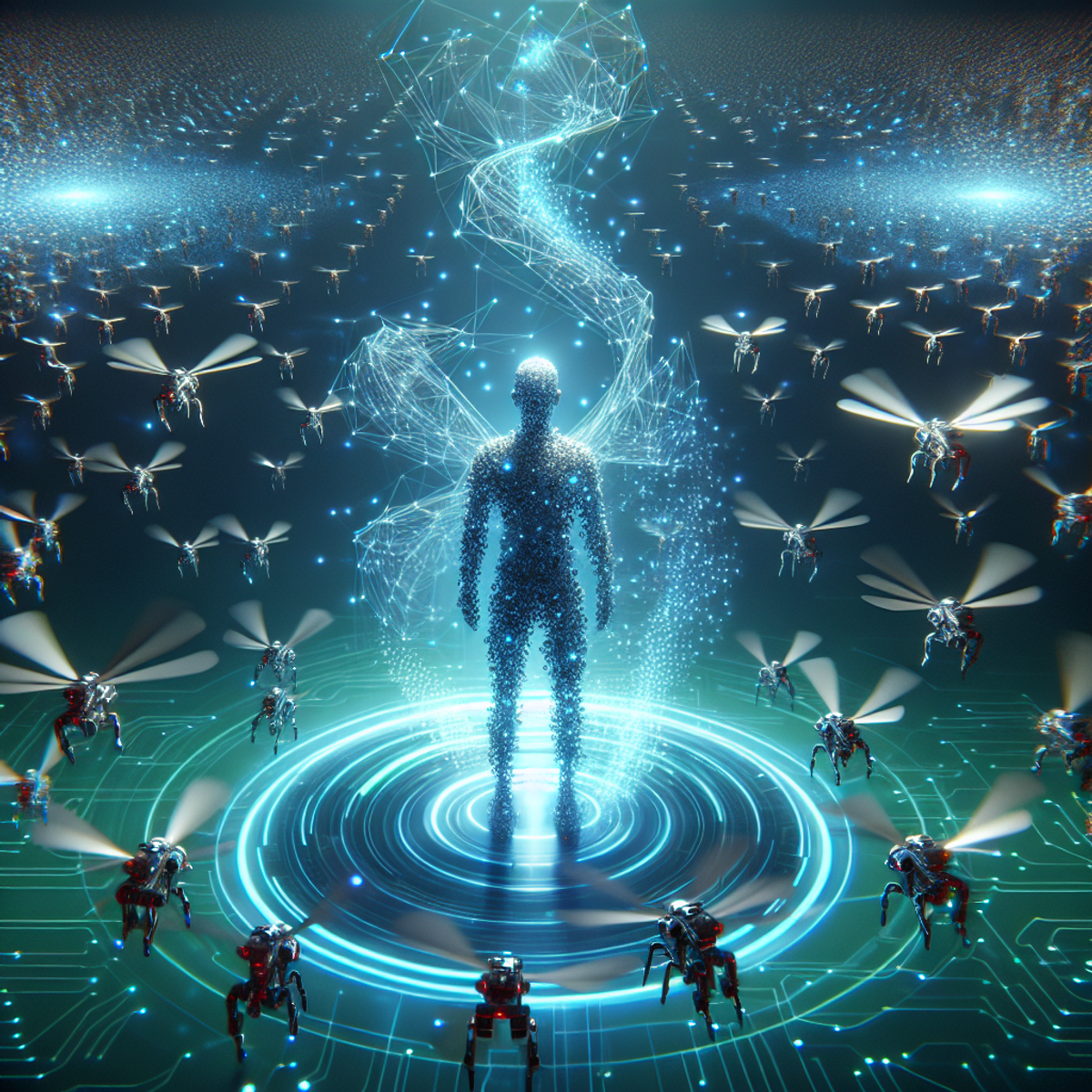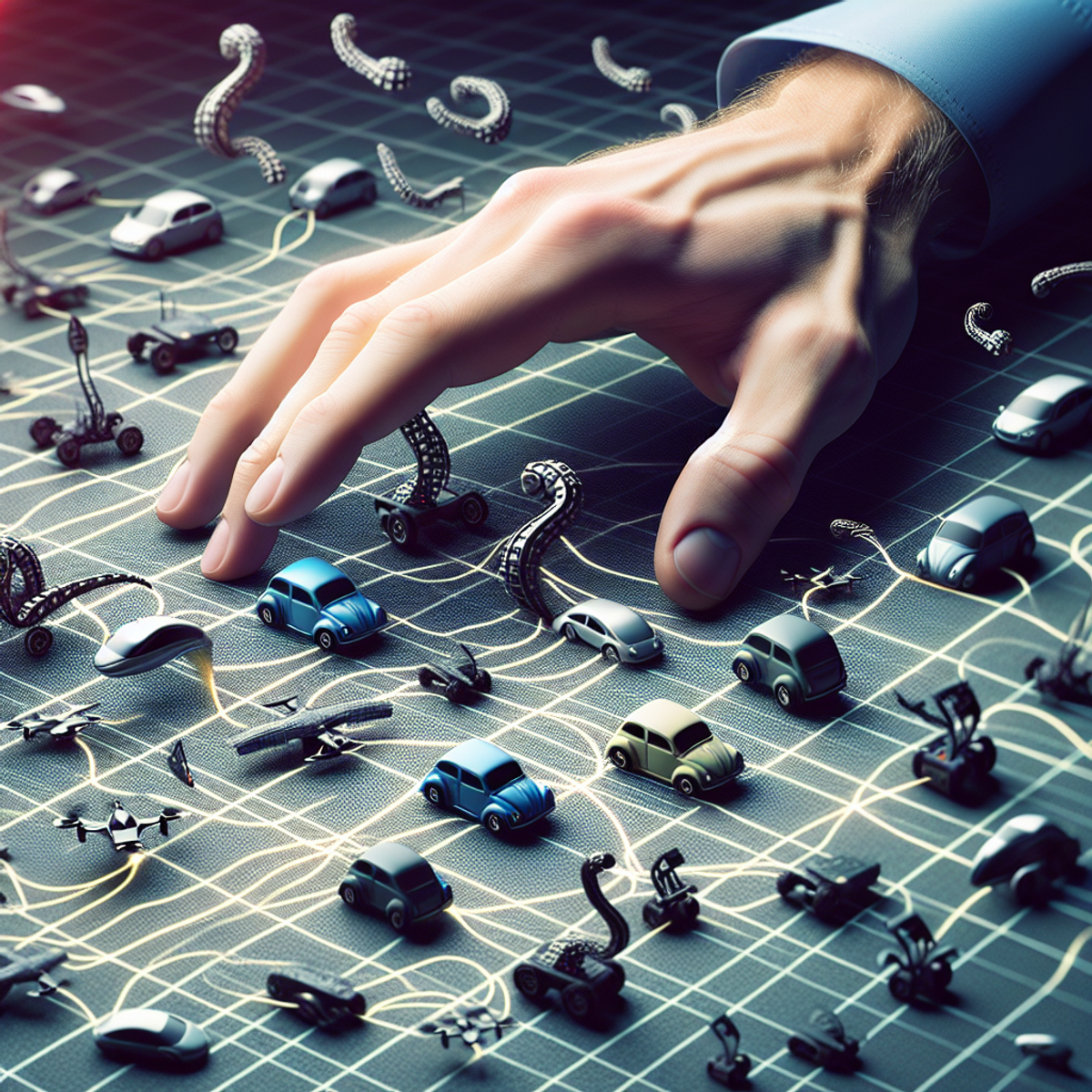Python and Drone Swarms: Autonomous Operations

Python and Drone Swarms: Autonomous Operations
Introduction
Python is becoming increasingly popular in the field of autonomous operations, particularly in the context of drone swarms. As technology advances, the concept of robot swarms has emerged as a promising solution for various applications. These swarms consist of multiple drones working together to achieve a common goal. However, effectively coordinating and controlling a large number of drones simultaneously poses significant challenges. This is where Python comes in.
Why Python?
Python's role in autonomous operations of drone swarms is crucial for several reasons:
- Simplicity and ease of use: Python is known for its simplicity and ease of use, making it an ideal programming language for beginners and experts alike. Its clean syntax and extensive libraries enable developers to quickly prototype and implement complex algorithms required for swarm coordination.
- Specialized libraries and frameworks: Python provides a wide range of libraries and frameworks specifically designed for robotics and autonomous systems. These tools offer functionalities such as path planning, sensor integration, and communication protocols, which are essential for managing drone swarms effectively.
- Integration with other technologies: Python's versatility allows seamless integration with other technologies, such as machine learning and computer vision. These capabilities enhance the autonomy of drone swarms by enabling them to adapt to dynamic environments and make intelligent decisions based on real-time data.
The Importance of Coordination in Drone Swarms
To understand the significance of Python in autonomous operations of drone swarms, it is crucial to recognize the need for effective coordination within these swarms. In a swarm scenario, each individual drone acts as part of a collective intelligence, contributing its capabilities to accomplish complex tasks that would be challenging or impossible for a single drone alone.
Effective coordination is essential to ensure that each member of the swarm performs its designated role without conflicts or collisions with other members. It involves various aspects such as task allocation, communication protocols, obstacle avoidance, and synchronization. Python provides the necessary tools to address these challenges efficiently.
Striking a Balance Between Human Control and Autonomy
In addition to coordination challenges, there is also a need to strike a balance between human control and autonomy in drone swarm operations. While autonomy enables drones to operate independently, human supervision remains vital to ensure safety, ethical considerations, and adaptability to unforeseen circumstances. Python facilitates this balance by allowing developers to implement control mechanisms that combine human intelligence with autonomous operations.
The Role of Python in Autonomous Operations of Drone Swarms
In the next sections of this article, we will delve deeper into the different aspects of Python's role in autonomous operations of drone swarms:
- Metaverse for Swarm Control: Exploring how the concept of the metaverse can enhance swarm control.
- Case Study: Human Control Enabled by Python: Examining a case study where Python enabled human control in a swarm of uncrewed ground vehicles (UGVs).
- Other Human-Swarm Interaction (HSI) Control Mechanisms: Discussing various control mechanisms for drone swarms that involve human-swarm interaction (HSI).
- Future Advancements in Python Libraries and Frameworks: Touching upon the future advancements in Python libraries and frameworks for swarm robotics.
By the end of this article, you will have a comprehensive understanding of how Python empowers autonomous operations in drone swarms and how it contributes to shaping the future of swarm technologies. So let's dive in and explore the fascinating world of Python and drone swarms.
1. Human Control over Swarm Members
Maintaining human supervision in autonomous drone swarms is crucial. While autonomous operations may sound appealing, having humans in control adds an important layer of oversight and decision-making for the safe and efficient functioning of drone swarms.
Controlling multiple drones at once comes with its own set of challenges, including avoiding collisions and managing complex mission objectives. Human operators play a vital role in being able to intervene in real-time and adapt to unexpected situations that may occur during swarm operations.
By combining human intelligence with autonomous operations, we can leverage the strengths of both. Human operators bring their cognitive abilities such as reasoning, intuition, and creativity to the table, which complement the precision and scalability of autonomous systems. This hybrid approach allows us to maximize the effectiveness of drone swarms while also addressing the limitations that come with fully autonomous control.
2. Leveraging the Metaverse for Enhanced Swarm Control
The concept of the metaverse presents an innovative approach to managing drone swarms, offering potential solutions to the challenges of coordinating a large number of autonomous agents. By creating a virtual environment for swarm coordination, the metaverse can provide scalable control and enhance the overall efficiency of robot swarms.
Introducing the Metaverse for Swarm Management
The metaverse, commonly defined as a collective virtual shared space, can be leveraged to address the complexities of controlling autonomous drone swarms. Researchers like Walid Saad are already studying this concept with great interest. By utilizing digital twins, which are virtual representations of physical objects or systems, a virtual environment can be created to mirror the real-world actions and behaviors of individual swarm members. This virtual representation allows for enhanced monitoring and control, leading to more effective coordination among swarm entities.
Exploring Digital Twins for Virtual Swarm Coordination
Digital twins play a crucial role in creating a virtual environment that mirrors the actions and interactions of drone swarms in the physical world. In fact, recent studies funded by organizations like the National Science Foundation have shown promising results in this area. By capturing real-time data and simulating the behaviors of swarm members, digital twins enable operators to make informed decisions and execute coordinated actions within the virtual space. This capability provides a powerful tool for managing complex swarm dynamics while maintaining human supervision over autonomous operations.
2.1 Virtual Agents and Sub-Swarms
In the metaverse approach, virtual agents act as intelligent entities that interface between the physical swarm and its digital twin representation. These virtual agents are responsible for interpreting commands, coordinating actions, and communicating with individual swarm members within the virtual environment. By leveraging virtual agents, operators can effectively monitor and influence swarm behavior while minimizing the cognitive load associated with directly controlling numerous drones.
Furthermore, dividing the swarm into sub-swarms within the virtual environment offers several advantages in terms of control and coordination:
- Sub-swarms enable operators to focus on smaller groups of drones, allowing for more granular supervision and targeted management of specific tasks or objectives.
- This subdivision strategy facilitates better control by reducing the complexity of overseeing an entire swarm while still ensuring cohesive collective behavior across all subgroups.
By embracing the metaverse and its associated technologies, such as digital twins, virtual agents, and sub-swarm divisions, stakeholders can unlock new opportunities for enhancing swarm control capabilities and driving advancements in autonomous operations.
The utilization of digital twins within a metaverse framework offers promising prospects for addressing challenges related to coordinating large-scale drone swarms. The integration of virtual environments, powered by digital twin technology and supported by intelligent agents, presents a scalable solution for effectively managing autonomous operations while maintaining human oversight.
This innovative approach enables operators to interact with drone swarms in a streamlined manner within a dynamic virtual space. By harnessing these technologies, stakeholders can optimize coordination strategies and maximize the efficiency of robot swarms through enhanced control mechanisms.
3. Case Study: Human-Controlled UGV Swarm with Python
In this section, we will look at a real-world example that demonstrates how Python can enable human control in a group of uncrewed ground vehicles (UGVs). Specifically, we'll explore a case study where gestural communication, powered by Python, was employed as a control method for a swarm of UGVs. Additionally, we'll delve into the impact of different levels of autonomy on the UGV swarm's performance.
Case Study Overview
The case study involved a swarm of UGVs conducting a search and rescue operation in a simulated disaster scenario. The objective was to locate and save survivors amidst an earthquake-stricken area. Python was utilized to develop the control system for the UGV swarm, allowing human operators to effectively coordinate and manage the swarm's actions.
Gestural Communication as a Control Method
A key highlight of this case study was the implementation of gestural communication as a Python-powered control method. Human operators were able to issue commands to the UGV swarm using gestures captured by depth-sensing cameras. These gestures were subsequently translated into higher-level commands that directed the swarm's behavior.
Python's flexibility and ease of use made it an ideal choice for implementing this gesture recognition system. Libraries such as OpenCV and PyTorch were leveraged to process the camera data and identify specific gestures made by human operators. The processed information was then transformed into actionable commands for the UGV swarm.
By combining Python with gesture recognition technology, the control system offered an intuitive and natural means for human operators to communicate with the UGV swarm. This approach facilitated easier operator training and fostered improved collaboration between humans and machines.
Evaluating Different Levels of Autonomy
To gain further insights into the capabilities of the UGV swarm, various levels of autonomy were introduced during the case study. The objective was to assess how these different levels impacted the swarm's performance.
- Level 1 Autonomy: Human control was paramount at this level. Operators were responsible for all decision-making and guiding the swarm's actions. This allowed for precise control and coordination but placed significant pressure on human operators.
- Level 2 Autonomy: At this level, certain tasks within the swarm were assigned to autonomous agents. These agents were programmed to make decisions based on predefined rules and heuristics. This reduced pressure on human operators, enabling them to focus on higher-level decision-making.
The results of the case study demonstrated that as the level of autonomy increased, the overall performance of the UGV swarm improved. Delegating simple tasks to autonomous agents allowed human operators to concentrate on more complex decision-making processes. However, it is important to note that human control still played a critical role in ensuring smooth operations and adapting to unforeseen circumstances.
Python's versatility played a pivotal role in implementing these varying levels of autonomy within the UGV swarm. The myriad of libraries available in Python facilitated rapid testing of different algorithms and control strategies.
Conclusion
The aforementioned case study effectively showcased how Python can be leveraged to provide human operators with control over a UGV swarm through gestural communication. By capitalizing on Python's capabilities, operators were able to seamlessly collaborate with the swarm using gestures captured by depth-sensing cameras.
Moreover, examining the different levels
4. Examining Other HSI Control Mechanisms for Drone Swarms
Existing HSI Control Mechanisms
When it comes to controlling drone swarms, there are various existing research and technologies that focus on facilitating human-swarm interaction in control systems. These mechanisms play a crucial role in enabling effective coordination and management of multiple drones simultaneously.
Gestural Communication in Drone Swarms
One particularly promising control modality for drone swarms is gestural communication. This intuitive method allows humans to interact with the swarm using hand gestures or body movements, providing a natural and efficient way to convey commands.
For example, in a research study conducted at a leading robotics institute, gestural communication was explored as a means of controlling a swarm of aerial drones. By implementing a system that could interpret specific gestures as commands for the drones, researchers demonstrated the potential for seamless human-swarm interaction through gestural communication.
Examples from Related Work
In recent years, there have been notable examples of gestural communication being employed in the context of drone swarm control:
- Gesture-Based Navigation: Researchers developed a system where hand gestures were used to direct the movement and positioning of drone swarms during reconnaissance missions. By employing predefined gestures for different actions such as "move forward," "hover," or "return," operators were able to effectively guide the drones without relying on complex manual controls.
- Collaborative Gesture Control: Another study focused on collaborative gesture control, allowing multiple operators to work together in controlling a large swarm of drones. By assigning specific gestures to individual drones within the swarm, operators could orchestrate synchronized movements and formations, showcasing the potential for intuitive multi-operator swarm management.
Integration with Python
Python's versatility and extensive libraries make it an ideal candidate for integrating gestural communication into drone swarm control systems. Through Python-based frameworks, developers can leverage computer vision and machine learning capabilities to interpret gestures and translate them into actionable commands for the swarm.
For instance, by using Python alongside computer vision libraries such as OpenCV, researchers have been able to develop real-time gesture recognition systems that enable seamless interaction with drone swarms. This integration underscores Python's role in enhancing human-swarm interaction through innovative control mechanisms.
Exploring Future Directions
While gestural communication shows great potential, there are still avenues to explore in terms of refining and expanding the use of HSI control mechanisms for drone swarms. For instance, further research could focus on developing more advanced machine learning algorithms that allow drones to understand complex and context-specific gestures.
Moreover, researchers like Matt Garratt are actively working on improving human-swarm interaction by exploring novel combinations of technologies. Collaborative efforts among experts in fields such as robotics, computer vision, and human-computer interaction will be instrumental in pushing the boundaries of HSI control mechanisms for autonomous swarm technologies.
Examining alternative human-swarm interaction (HSI) control mechanisms such as gestural communication presents exciting prospects for advancing the coordination and management of drone swarms. By leveraging intuitive modalities like gestural communication, developers and researchers can pave the way for more accessible and efficient ways of interfacing
Future of Python and Autonomous Drone Swarms
As technology continues to advance rapidly, the future prospects of Python in the realm of autonomous drone swarms are becoming increasingly promising. Let's explore the ongoing advancements in Python libraries and frameworks for swarm robotics and the potential for innovation at the intersection of Python programming and drone swarms.
Advancements in Python Libraries and Frameworks for Swarm Robotics
Python has become a popular language for robotics and automation, offering many libraries and frameworks designed specifically for swarm robotics. Here are some notable advancements:
1. Robot Operating System (ROS)
ROS provides a comprehensive set of libraries and tools for building complex robot applications. Its integration with Python allows seamless connection with Python-based applications, making it easier to develop advanced swarm control systems.
2. Pygame
Pygame is widely used for creating interactive simulations and games. It can also be applied to swarm robotics by providing a platform to develop visually appealing simulations of drone swarms. This feature enables researchers and developers to test control algorithms in a simulated environment before actual deployment.
3. OpenCV
OpenCV is an open-source computer vision library that offers strong support for image processing tasks essential in coordinating drone swarms. With its Python bindings, developers can utilize advanced vision-based algorithms to improve the visual capabilities of individual swarm members.
Encouraging Innovation at the Intersection of Python Programming and Drone Swarms
The combination of Python programming with autonomous drone swarms presents various opportunities for future innovation. Here are some areas where creative thinking and experimentation can thrive:
1. Behavior-Based Control
Python's flexibility and simplicity make it ideal for implementing behavior-based control approaches in swarm robotics. By defining high-level behaviors using Python code, developers can coordinate complex interactions among swarm members to achieve common goals.
2. Machine Learning Integration
As machine learning continues to transform robotics, Python's vast collection of machine learning frameworks (such as TensorFlow and PyTorch) provides an exciting chance to incorporate intelligent decision-making abilities into drone swarms. By implementing machine learning algorithms in Python, swarm operations can benefit from adaptive path planning and collaborative task allocation, leading to increased autonomy and adaptability.
3. Real-Time Data Analytics
Processing sensor data in real-time is critical for enabling situational awareness and quick decision-making in autonomous drone swarms. Python's data analytics libraries (like Pandas and NumPy) empower developers to leverage real-time data processing, extracting valuable insights from sensor inputs and facilitating agile swarm coordination in dynamic environments.
By exploring these innovative possibilities where Python programming and autonomous drone swarms intersect, researchers, engineers, and enthusiasts can actively contribute to shaping the future of swarm robotics.
Conclusion
In the world of drone swarms and autonomous operations, Python plays a crucial role in enabling effective coordination and control. Throughout this article, we have explored various aspects of Python's involvement in the realm of autonomous swarm technologies. From maintaining human supervision to leveraging the metaverse for enhanced swarm control, Python proves to be a versatile and powerful tool.
Emphasizing the Need for Balance
As we delve deeper into the realm of drone swarms, it becomes evident that a balanced approach between human control and autonomy is essential for realizing their full potential. While autonomous operations offer increased efficiency and scalability, human intelligence and decision-making play a vital role in ensuring safety, adaptability, and ethical considerations.
By combining the power of Python with human supervision, we can strike this balance effectively. Python's versatility allows developers to create sophisticated algorithms that can process vast amounts of data and make intelligent decisions in real-time. This enables humans to retain control while benefiting from autonomous capabilities.
Shaping the Future of Autonomous Swarm Technologies
Python's role in shaping the future of autonomous swarm technologies cannot be overstated. With its ease of use, extensive libraries, and frameworks tailored for swarm robotics, Python empowers developers to innovate and push the boundaries of what is possible.
As advancements in Python continue to emerge, we can expect even greater possibilities for autonomous swarm technologies. The ongoing development of libraries and frameworks specific to swarm robotics will provide developers with more tools to enhance coordination, communication, and control within drone swarms.
Furthermore, Python's compatibility with other programming languages and its ability to integrate with various hardware platforms make it an ideal choice for building robust systems that can seamlessly interact with drones and other devices.
A Continuation of Exploration
While this section concludes our discussion on the role of Python in autonomous operations of drone swarms, it is important to note that there are still many exciting avenues left unexplored. The field of human-swarm interaction (HSI) control mechanisms continues to evolve, and Python will undoubtedly play a significant part in these advancements.
As researchers and developers continue to explore new control modalities, such as gestural communication, Python's flexibility will enable the development of intuitive and efficient methods for humans to interact with drone swarms. This opens up possibilities for a wide range of applications, from disaster response and surveillance to delivery services and entertainment.
In conclusion, Python's involvement in autonomous operations of drone swarms is vital for achieving effective coordination, control, and innovation. By striking a balance between human supervision and autonomous capabilities, we can unlock the full potential of drone swarms while ensuring safety, adaptability, and ethical considerations. As Python continues to evolve and advance, the future of autonomous swarm technologies looks promising, and it is an exciting time for those interested in exploring this intersection of technology and robotics.
FAQs (Frequently Asked Questions)
What is the role of Python in autonomous operations of drone swarms?
Python plays a crucial role in enabling autonomous operations of drone swarms by providing a versatile and powerful programming language for controlling and coordinating the swarm members.
Why is it important to maintain human supervision in autonomous drone swarms?
Maintaining human supervision in autonomous drone swarms is important to ensure effective control and decision-making, especially in complex and dynamic environments. Human intelligence can provide valuable insights and adaptability that are essential for successful swarm operations.
How can the metaverse be leveraged for enhanced swarm control?
The metaverse can be leveraged for enhanced swarm control by creating virtual environments using digital twins, allowing for scalable control and management of robot swarms. Additionally, virtual agents and sub-swarms can facilitate better coordination within the metaverse approach.
Can you provide a case study where Python was used for human-controlled UGV swarm?
Certainly! A real-world case study showcased the use of Python to enable human control in a swarm of uncrewed ground vehicles (UGVs). The case study also demonstrated the use of gestural communication as a Python-powered control mechanism for the UGV swarm.
What are some existing research and technologies facilitating human-swarm interaction in control systems?
There are various research and technologies focusing on human-swarm interaction (HSI) control mechanisms, including gestural communication as an intuitive control modality for drone swarms. These approaches aim to enhance the coordination and communication between humans and autonomous swarms.
What is the future prospect of Python libraries and frameworks for swarm robotics?
The future prospects of Python libraries and frameworks for swarm robotics are promising, with ongoing advancements aimed at further enhancing swarm control capabilities. The intersection of Python programming and drone swarms holds potential for future innovation in autonomous swarm technologies.
Why is a balanced approach between human control and autonomy important in realizing the full potential of drone swarms?
A balanced approach between human control and autonomy is crucial in realizing the full potential of drone swarms as it combines the strengths of human intelligence with the efficiency of autonomous operations. This balance enables adaptability, decision-making, and effective coordination essential for successful swarm technologies.




Comments
Post a Comment